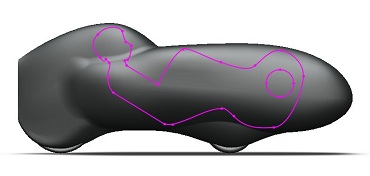Fairing Design
October 29, 2012
At the beginning of the month the team set a fairing design deadline for the end of the month, an ambitious deadline given that last year we didn't complete our fairing design until the spring.
The whole team has been working hard to achieve this over the course of the month, ideating on designs, sketching out concepts, modeling prototypes and performing Computational Fluid Dynamic Analysis.
After countless hours of work, we have come up with a design which we are extremely happy with, shown at right.
Last year's fairing (2012) was both the smallest and most aerodynamic fairing the team has ever built. According to STAR-CCM+, the vehicle has a Cd of 0.0870 and a CdA of 0.0358 m2. However, the vehicle was heavy, contained quite a bit of empty space, was larger than necessary, and did not have great visibility from within.

To redesign the fairing, we began by ideating on potential fairing shapes and ended up converging on the same basic four shape concepts which we identified during our fairing research last year. More information on these shapes can be found in our 2012 Design Report.
According to the preliminary CFD analysis we performed last year, the Torpedo shape is the most aerodynamic of the shapes. However, we decided that such a small volume with poor visibility would adversely affect rider confidence, which our testing indicated would significantly decrease rider performance. The Duck and Wedge designs had comparable aerodynamic properties, with the Wedge having a slight advantage.
For this upcoming year, we are looking to build a fairing inspired by the Duck. Although the Duck is not quite as aerodynamic of a shape as the Wedge, the nature of the design brings the window closer to the rider's face, allowing for a smaller window and what we predict will be a lighter fairing overall.
We have modeled the Duck and have edited the curves until they are smooth flowing and tightly hug the curves of the rider. After several iterations of design and analysis using CD-adapco's STAR-CCM+, our analysis tool of choice, we have what we believe to be an extremely aerodynamic shape. As shown in the table below, the concept is about 8% more aerodynamic than our previous year's design.
The fairing concept hugs the profile of the rider very tightly and is extremely compact. According to our rider measurements, it will be able to (comfortably) fit all of our riders. However, to validate this, we hope to use cardboard cutouts of the shape to confirm fit in the coming weeks.
At this point, we consider our fairing design process to be at least 75% complete. We still have work to do and will continue to iterate upon our shape to make it more aerodynamic and functional. The team's goal is to finish our fairing design and construct molds by the end of the semester.
| Fairing | CdA (m2) |
|---|---|
| 2011 Vehicle | 0.0409 |
| 2012 Vehicle | 0.0358 |
| 2013 Concept | 0.0330 |


